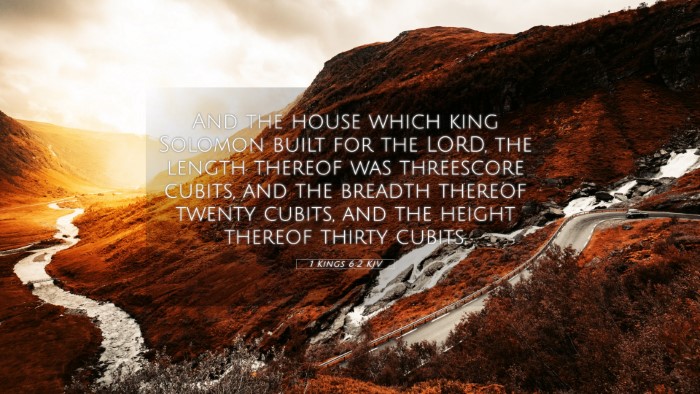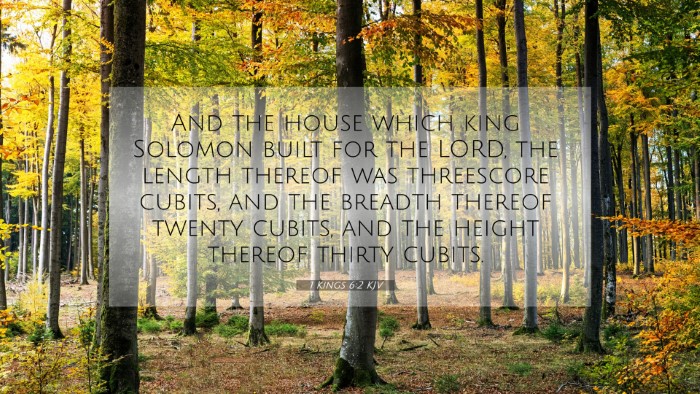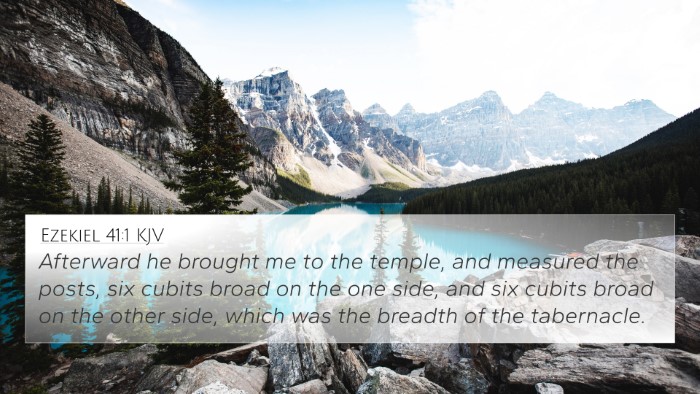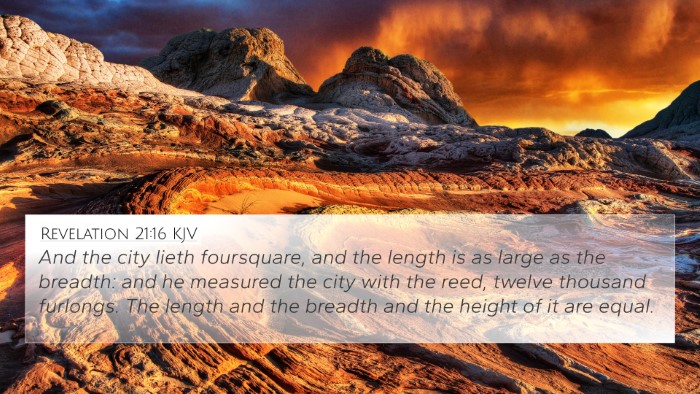Understanding 1 Kings 6:2
1 Kings 6:2 states: "And the house which king Solomon built for the LORD, the length thereof was threescore cubits, and the breadth thereof twenty cubits, and the height thereof thirty cubits." This verse marks the beginning of a significant phase in the history of Israel, focusing on the construction of the Temple in Jerusalem. Here, we will explore the rich meanings and connections found within this verse using insights from public domain commentaries.
Summary of Key Themes
- The House of the Lord: The Temple is a central aspect of Israel's worship, symbolizing God's presence among His people.
- Dimensions of the Temple: The specified measurements highlight the grandeur and significance of Solomon's Temple.
- Historical Significance: This moment is pivotal in Israel’s history as it reflects God’s covenant promises to David and Solomon.
- Divine Design: The meticulous details underscore the careful planning directed by divine guidance and inspiration.
- Foreshadowing of Christ: The Temple serves as a typological foreshadowing of Jesus Christ and His role as the ultimate dwelling place of God among man.
Exegesis and Commentary Insights
According to Matthew Henry, the construction of the Temple signifies a fulfillment of God’s promise to David that his son would build a house for the Lord. This act not only represents a physical building but also embodies the spiritual condition of Israel, calling the people to unity in worship and the acknowledgment of God's sovereignty.
Albert Barnes emphasizes the dimensions given in 1 Kings 6:2. The length of sixty cubits, width of twenty cubits, and height of thirty cubits suggest a structure that is not only vast and impressive but also reflects the importance of order and divinity in its construction. Solomon’s attention to detail demonstrates his dedication to honoring God through this monumental task.
Adam Clarke elaborates on the significance of the Temple itself. He explains that it would serve as a place where the community could gather, worship, and experience God's presence in a unique way. Clarke also notes the historical context, mentioning how the building of the Temple was a transformative moment for Israel that established Jerusalem as the spiritual center of the nation.
Cross-References and Thematic Connections
When examining 1 Kings 6:2, several cross-references enhance our understanding:
- 2 Samuel 7:1-13: God's covenant with David regarding his lineage and the establishment of a house for the Lord.
- 1 Chronicles 28:11-19: Instructions given to Solomon by David about the design of the Temple.
- Exodus 25:8-9: God's command to build a sanctuary, linking the Temple to the Tabernacle's heritage.
- Haggai 2:9: Prophecy concerning the glory of this latter house, relating to its significance in later biblical history.
- Hebrews 9:11-12: The contrast between the earthly Temple and the heavenly sanctuary, indicating a greater fulfillment in Christ.
- Matthew 12:6: Jesus’ teaching that He is greater than the Temple, signifying the shift from physical to spiritual worship.
- John 2:19-21: Jesus referring to His body as the Temple, metaphorically linking the structure in Jerusalem to Himself.
- Revelation 21:22: Vision of a new Jerusalem where there is no Temple because God and the Lamb are the temple, encapsulating the fulfillment of the concept of dwelling with God.
Conclusion: Theological Implications
1 Kings 6:2 highlights the intersection between God's presence and His people's response to Him through worship. The detailed measurement not only illustrates the greatness of Solomon’s work but ultimately signifies the greater work God is doing through Jesus Christ, the true Temple. As believers, understanding these connections between scripture allows us to appreciate God's unfolding redemptive story throughout the Bible.
Tools for Further Study
For those looking to deepen their understanding of Bible verses through cross-referencing, consider the following tools:
- Bible Concordance: A resource for finding specific verses and their locations within the text.
- Bible Cross-Reference Guide: Guides that help connect related scriptures across both Testaments.
- Cross-Reference Bible Study: Methods to systematically explore the interconnectivity of Bible verses.
- Bible Reference Resources: Tools that assist in developing a deeper study of themes, characters, and historical contexts.






